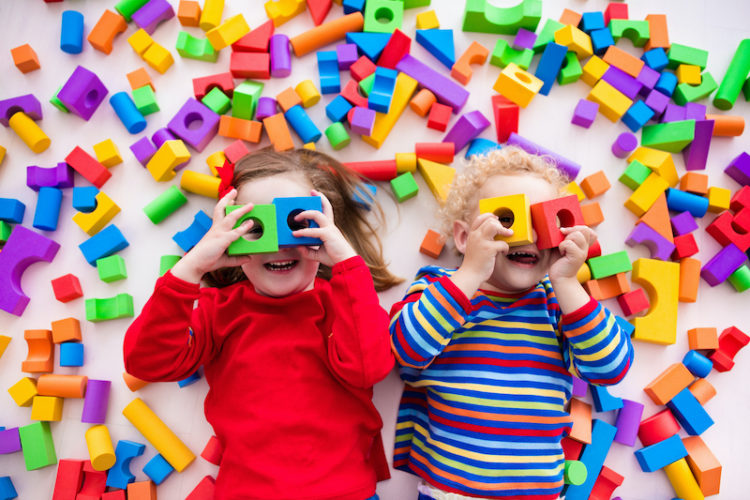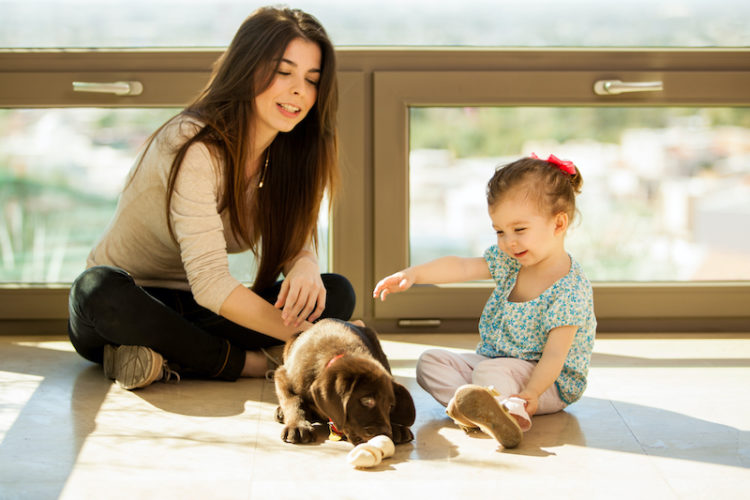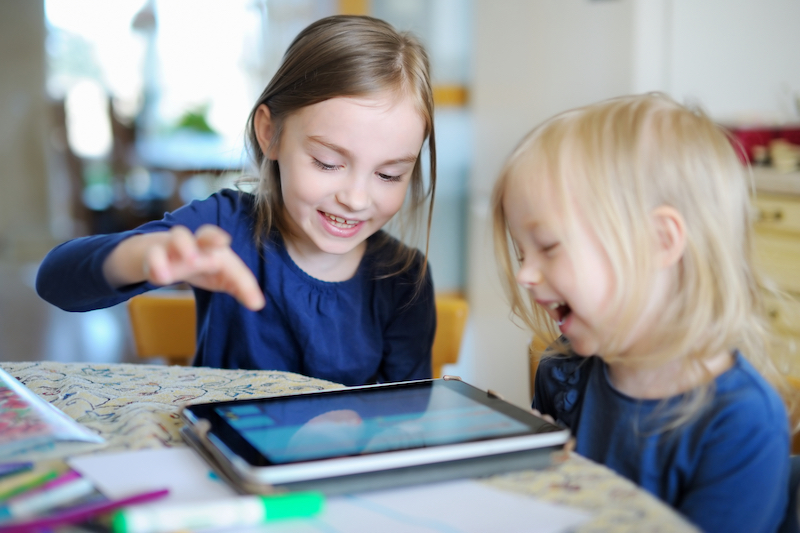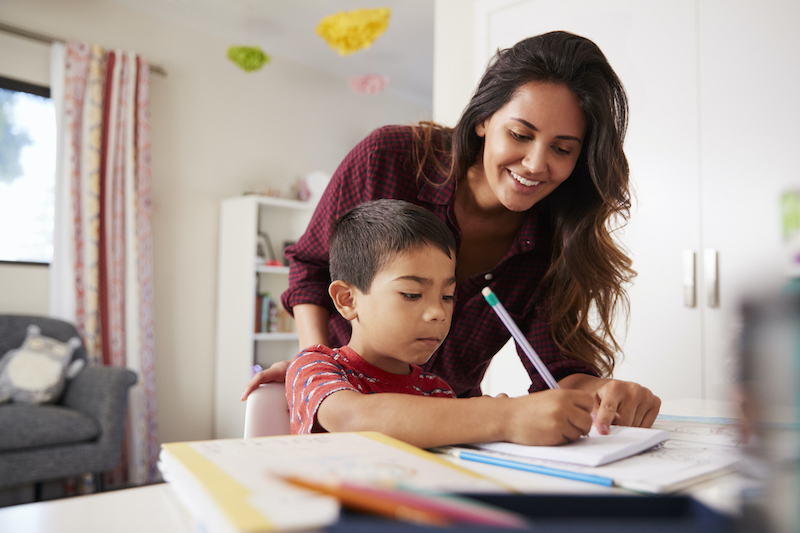In an increasingly globalised world, the need for children to fluently understand more than one language is becoming more important every day.
By far the best time for us to learn a language is as a child. Their minds are more malleable and able to form new connections at a much quicker pace than later on in life.
Young kids are simply natural language learners. Unlike teenagers and adults, they don’t require self-motivation or outside reward. Every day walking around as a child is a constant influx of new information. Information that is being happily and rapidly absorbed.

This is especially true for whatever languages are surrounding that child.
But as a parent, it can be difficult to teach a kid a new language — especially if it’s not spoken at home.
Don’t fret though, there are several scientifically-backed ways to help your kids on their path to becoming fluent in a new language!
This article aims to help parents understand why it is important for their kids to learn additional languages.
It also covers how children learn, the stages of language development, and different methods for learning.
If you, as a parent, take the time to read through this, you’ll gain a better understanding of how to help your kid navigate the world of learning a second language — or even a third!
Let’s get started.
Table of Contents
- What are the Benefits of Learning a Second Language?
- Why are Kids Especially Suited for Learning Another Language?
- How Does a Child Learn a New Language?
- What are the Stages of Language Development in Children?
- What are the Different Styles of Learning Languages?
- How to Measure a Child’s Language Learning Progress?
- Ways to Support Language Development
- Studycat is Here to Help
What are the Benefits of Learning a Second Language?
The study of language learning has come a long way in recent decades thanks to countless research by linguistic professionals around the world.
Contrary to popular belief, helping a young child learn a second language doesn’t negatively affect the development of their native language.
In fact, it’s been shown to help improve children’s understanding of their native language too!
Dr. Ellen Bialystok, a researcher of bilingualism for over 40 years, has found that bilingual students are especially inclined to having better grammar abilities than their monolingual peers.
The effect is even more pronounced by the time they get to high school. Studies show that foreign language learners perform better in their native English SAT scores than English-only students.
It’s amazing to think that children learning another language from a young age can actually improve the comprehension of their own native tongue!
And that’s not all.
Many studies have shown a multitude of perks from learning a second language.

Benefits of Children Learning a Second Language
- Increased understanding of grammar in different languages
- Better performance in native language tests over time
- Improved focus and capacity for cognitive flexibility when compared to peers
- Faster and increased development of empathy, social skills, and theory of mind in children
- Better spatial reasoning skills when dealing with multitasking
- Improved ability to learn a third, fourth, or fifth language later on
- Better opportunities for college and university
- Higher earning potential as adults in their careers
- Proven to have more grey matter than their peers
- A more natural-sounding accent in the second language
- Higher test scores than their peers
As we can see, there are many great benefits for children when they have the chance to learn a second language at a young age.
The best part? The benefits continue throughout their life. From better colleges to higher-paying careers, your kid will truly be thankful you gave them the opportunity to be bilingual.
It may even give them chances to go abroad or lead to cultural exchanges they may never have had the opportunity to experience without the language.
Even when they’re old and grey — the benefits don’t stop. Studies are starting to show that being multilingual can help offset different forms of dementia.
A study by researchers from the UK and India found that Alzheimer’s, in particular, could be delayed as much as 4.5 years for those that understood more than one language!
Learning, reading, and speaking another language truly is a wonderful thing.
While there is certainly a case for everybody to start learning another language — it is especially true for young children!
Why are Kids Especially Suited for Learning Another Language?
As adults, it is much harder to learn a new language. It’s a well-known fact that it is much easier to learn a language the younger you are.
But why is that?
The main school of thought these days revolves around the difference between our two main types of memory systems.
- Declarative memory — The active recollection of a memory, experience, or information.
- Procedural memory — The subconscious part of the mind that aids us in performing actions like reading, riding a bike, and opening a door.
As adults, we have trained our brains to rely on declarative memory when learning new tasks and skills.
We are able to recall our favorite teachers, the names of countries on a map, and each card in a normal playing deck.
And of course, we make use of procedural memory all the time too.
You’ll never forget how to ride a bike, even if you haven’t ridden one in years. Perhaps you haven’t driven a car lately, but I bet you still know how to drive one.
The many actions and activities that we learn as children (and later as adults) lead to our database of procedural memory.

Kids, on the other hand, haven’t had the years of experience that adults do in learning about new activities, instructions, and important events.
They haven’t yet learned important dates in history, the difference between animals and reptiles, or the results of last year’s elections.
That is, their declarative memory is mostly unformed at this stage. And that’s a good thing for language learning — it serves as a distraction for adults when learning.
Children aren’t distracted by a fully developed declarative memory system — and are able to learn languages much quicker as a result.
At its core, children are better at learning by doing, while adults tend to learn about things.
This key difference is why children are much more adept at learning languages than adults.
Of course, there are other factors that help children learn languages:
- They have much more free time than adults
- They’re in a learning environment most of the day while we have to work
- In the first few years, children experience massive growth in neural connections — over 1 million per second up to the age of three!
- Children don’t experience the same level of fear or self-consciousness that adults do — they are free to fail, make mistakes, and learn from them faster than we can
- They have less to learn — no one expects a young kid to be writing Shakespeare prose — they are able to form the building blocks of a language naturally whereas we tend to focus on structures and systems of languages
- babies can learn two languages as fast as one language
Now that we know a few of the reasons why children are perfectly built for learning new languages, we can explore how they learn at that age.
How Does a Child Learn a Language?
There’s no doubt that kids are easily able to learn languages in their formative years. But this process gets a bit more interesting when we look at just why that is the case.
There are a few different trains of thought as to why they’re able to pick up languages so quickly, but there is one common underlying factor — interaction.
Children Learn New Languages Through Interaction With Other People
Kids develop a lot of their language skills during their formative, or early years. The more input they receive from people around them, the stronger the skills no matter the language.
Children learn from listening to adults, teachers, and other children they interact with. Later on, they begin expressing themselves to talk back to them.

These two phases of linguistic development are called receptive language and expressive language.
Receptive language is the ability to understand words and sounds in the environment around children. Whereas expressive language is the ability to use words, sounds, and motions to communicate meaning to other people.
During the development of these language abilities, kids make mistakes (but don’t chastise themselves as we do), learn from it, and say the correct word or phrase the next time.
This is part of the reason why it’s such a great time to start teaching them multiple languages. As long as the child continues to interact with someone who is speaking the other language, they will continue to learn.
If that happens to be two languages, say one from each parent, then they’ll learn two languages quite easily!
If we want to learn more about this, it helps to look at the specific stages in language development for children.
What are the Stages of Language Development in Children?
There are different ideas for how many distinct stages occur in children’s linguistic development. Fortunately, researchers do seem to agree on specific phases and metrics for the different ages.
During pregnancy:
There is some evidence that shows the very beginning of language learning starts while still in a mother’s womb. While not specific to actual words, it’s the beginning of the process of language learning.
- Babies start developing their hearing brain functioning at about 30 weeks of gestation
- A study in Acta Paediatrica found that babies start listening to their mother’s voice in the 10 weeks before birth
- The same study even showed signs babies can tell the difference of vowel sounds between their mother’s language and another
0–3 months old:
At this phase, babies are still quite receptive to the environment around them. They’re unable to express themselves beyond a few basic sounds and motions. But they are constantly absorbing all new information and noise around them.
During this stage, most babies are able to do the following:
- Cry in slightly different ways to show a different need
- Make noises showing pleasure or happiness, an early form of laughter
- Face toward familiar voices
- Smile or get quiet when being talked to
- Make basic vowel sounds like ‘aaaa’ and ‘oooo’
- Begin cooing and repeating sounds over and over
4–6 months old:
This stage of development in children’s linguistic skills begins to mark more imitation of those around them.
- Babies will start watching mouth movements
- Imitation of tone and sounds of adults
- At around 6 months of age, they can open and close their vocal tract
- After this, babies will play with varying the pitch, rate, and volume of sounds
- Reduplicated sounds (or canonical babbling) will start to occur — words like ‘baba’ and ‘mama’
7–12 months old:
Babies start to get much more interactive at this phase. They’ll continue to experiment with different basic functions of a language, all towards creating the basic building blocks of speech.
Most babies at this age are able to:
- Imitate motions and gestures
- Imitate tones in speech
- More complex babbling that contains mixes of vowels and consonants — random sounds like ‘ma di ba bo bay’
- Start forming adult-like intonation and word stressing
- Create non-speech sounds and imitate speech sounds (even if they can’t pronounce the words)
- It begins to sound like a language unique to the child — this is called the ‘jargon stage’ or conversational babbling
- Begin imitating rhythms and inflections
- At the end of this stage, many babies are able to say one or two basic words
1–2 years old:
This is the age where most children really start forming their first sentences and learning vocabulary. You’ll often be surprised at just how quick this can occur, especially after 18 months old!
At this stage, kids are often able to:
- Know a vocabulary of at least 50 words
- Ask basic questions
- Follow simple one or two-step instructions
- Point at familiar things, animals, and people
- Learn a significant amount of vocabulary after around 18 months old
2–3 years old:
After reaching the age of two, many children start advancing their conversation abilities.
Most kids in this age group can:
- Form longer sentences
- Use pronouns like ‘me’, ‘he’, ‘her’
- Begin using simple adjectives and descriptions
- Answer simple questions
- Use inflection in their questions
- Start referring to things that happened in the past
- Show the beginning of the use of plurals
3–4 years old:
By the time many children around the world are ready to enter pre-school, their language abilities are at a decent level for basic communication.
Most children this age are able to:
- Identify colors
- Use group objects (collective nouns)
- Use most speech sounds but likely distort some of the more difficult ones (like th, sh, ch, l, r, s, y, v, z)
- Communicate better with strangers. Before this, there’s usually a marked difference between a parent’s understanding of a child’s speech versus someone unused to it.
- Start repeating whole sentences
4–6 years old:
This age marks the first steps into kindergarten or primary school for many kids around the world. This requires a certain level of communication in order for these kids to effectively learn all of the other subjects apart from language.
Most children at this age are able to:
- Describe how to do things, like drawing a picture
- Understand more complex questions
- Properly pronounce many more words, but still, struggle with long or difficult ones
- Understand positioning language, like underneath or beside
- Use more complex forms of irregular past tense verbs such as ‘gone’ or ‘eaten’
- Answer questions that start with ‘why’
- Have a grasp of time sequences in sentences
- Perform 3–4 step actions when asked
- Start to rhyme or at least understand the concept of it
- Describe objects in real life or in drawings
- Use compound and more complex sentence structure
What are the Different Styles of Learning Languages?
There are thousands of different styles of learning that were developed as classifications starting in the 1970’s. Unfortunately, there’s a lot of disagreement as to whether any such program or style is actually effective or not.
There’s a good reason for that — every person is different and learns in a slightly different way.
“A person might be more extraverted than introverted, or more closure-oriented than open, or equally visual and auditory but with lesser kinesthetic and tactile involvement.” — Madeline E. Ehrman on different learning styles
There have been many learning systems developed to try to explain how people learn new subjects, especially language.
Models such as David Kolb’s model or Peter Honey and Alan Mumford’s model, both revolve heavily around an idea of cyclical learning. The latter was even heavily applied in UK schools previously.
Other systems prefer to think of learning a subject as a perspective approach. That is, they try to explain the process of understanding something new not as a cycle, but rather as a function of how people learn.
Models such as learning modalities and Neil Fleming’s VARK attempted to explain how people can learn easier by using activities they are best suited for — e.g., using graphs and pictures for visual learners, and listening to music and lectures for auditory learners.
There are a few more prominent models that have been developed over the decades.
The main problem is almost all of them have been debunked to one degree or another.
So where does this leave us?
Optimizing Our Children’s Learning Abilities
There are two key points to remember:
- Children learn by exposure to new experiences, places, and things
- Children have shorter attention spans
The more sights, sounds, and learning experiences you can encourage your kid to have throughout their formative years, the better.

Tying this to language learning, if as many of these experiences as possible take place using even one aspect of the target language, you can count that as contributing to your kid’s learning.
Even more importantly, finding learning activities that both involve the target language AND are fun for children is crucial to intrinsic language learning.
If your kid naturally wants to keep playing a language learning activity without a parent forcing them to, they won’t view it as a chore.
If they get a natural enjoyment out of doing these things, forget about making them do their homework — you might find they’ve already completed it by the time you check!
Perhaps it’s best to think of an analogy. We all like to eat food, right?
People around the world eat a huge variety of cuisines everyday. Often even in the same countries.
Some people don’t drink milk. Others eat cheeseburgers every day. I personally love eating mangoes and dragon fruit as often as I can.
The point is, we all ingest a huge assortment of food on a daily basis. This food contains an even wider variety of nutrition, vitamins, and minerals. (Not all healthy of course.)
Yet, we all keep moving every day.
Despite all the differences in what we eat, our bodies know how to digest it.
The fuel goes in, and we keep living.
What’s important is that we ingest a plethora of different foods everyday to make sure we receive all the essential vitamins important to keeping us healthy.
And why do we keep eating every day? Because it’s delicious and we enjoy it!
The same two concepts apply to language learning for kids:
- Exposure to a wide variety of fun activities that include the language
- Keep doing those activities daily
The important thing to remember is the more immersion and interaction your child has with a second language — the quicker and better they’ll learn!

How to Measure a Child’s Language Learning Progress?
For those parents that already have fluency in the desired second language of the child, measuring the learning progress is a bit easier.
You’ll likely already have a feel for how they are progressing in the language based on your own past experience.
For those parents without knowledge of the second language, this can be much more difficult. Fortunately, there are ways to measure progress and see how your child is developing.
For adults, one of the most versatile measurement systems is called the Common European Framework of Reference for Languages (CEFR). This may not be suitable for kids however, as it is implied to measure full fluency.
Additionally, the way young children actually learn languages is almost completely unique to each child’s environment and experience.
This can lead to inaccurate interpretation and understanding when applying the same test across a range of individuals.
So, what are the different ways to assess our children’s language development?
Teachers and Tutors
If your kid is fortunate enough to be taught another language by a tutor or a teacher, they will definitely have a good understanding of their language level.
Frequent checkups and inquiries about your child’s progress will let you know what areas your kid may be lacking in or excelling in. This will help you better focus the activities outside of the classroom to encourage learning.
Language Learning Apps
Language learning apps like Studycat and DuoLingo have built-in tests throughout the games and study modules of the program.
This is a great way to check your kid’s progress without going through the effort of formal testing or ringing up the language teacher.
Most of these apps also keep an ongoing assessment level, so you can check progress, activity, and how often your child is using the app to learn.
Online Tests
Organizations such as Cambridge English have online tests for different ages to measure their language level. While these can be useful, they may not measure the full extent of progress.
English:
Spanish:
Chinese:
French:
German:
Ways to Support Language Development
There are usually two types of situations parents find themselves in when trying to get their kid to learn another language.
- One or both of the parents is fluent in the other language
- Neither of the parents speaks the other language
Typically, the first option is more congruent with teaching children how to speak more than one language. As long as both parents are able to spend lots of communicative time with the child, they’ll gain exposure to two languages.
If that continues into later childhood, the building blocks for bilingualism have been put in place!
With enough activities, socialising, and the right kind of teaching to reinforce all of the different concepts of a language — that kid will have a huge head start.
For those parents that aren’t fortunate enough to already speak more than one language, things can be a bit more difficult.
But now more than ever, there are ways to help parents teach their kids subjects they aren’t familiar with themselves!
Online Tutoring
With the advent of the internet, advances in image processing and internet speeds around the world, video conferencing technology is now easily accessible to many people.
This technology change has allowed a lot of companies to create online tutoring businesses — in almost any subject imaginable! This certainly includes language learning too.
Example online tutoring companies for language learning:
Language Learning Apps, Software, and Courses
There is also a plethora of phone apps, computer software, and online courses for people to consume in the modern world. These are great as most households now have multiple devices for kids to learn on — computers, phones, and tablets.
Examples of effect language learning apps for kids:
Many of these apps and software programs offer both free and paid versions. Feel free to look up reviews and recommendations for each of them, depending on your language requirements!
Language Learning Classes and Schools
As people from around the world might be reading this, it would be difficult to list the tens of thousands of language schools.
But luckily we have Google! A neat trick to find local sources for things is to add on the words “near me” at the end of a Google search.
So please open another tab on your browser and search for things like:
- “Spanish classes near me.”
- “Chinese Mandarin schools near me.”
- “French teachers near me.”
- “German tutors near me.”
You get the idea.
Youtube Channels
The massiveness and popularity of Youtube these days is almost unbelievable. Not only is it considered the second most popular website in the world, but it also has over 500 hours of video uploaded every single minute!
And within those millions of hours of videos are videos for every question and niche imaginable. Including learning languages!
Examples of popular Youtube channels for learning languages:
- Innovative Language Learning Channel
- Easy Languages Channel
- Travel Linguist Channel
- Learn Language Channel
- Kids Online English
Books for Parents
One other way to help your kid learn another language is to improve your own knowledge of just how to do that. While there are many books available out there, these following ones tend to be the most recommended on Amazon.
Recommended books for parents to help children learn languages:
- The Bilingual Edge
- Scaffolding Language, Scaffolding Learning
- Maximize Your Child’s Bilingual Ability
- Culturally Responsive Teaching and The Brain
Studycat is Here to Help
Ignite your child’s natural learning ability with our award-winning and fun language learning programs. Over 15 million families around the world have used our cutting-edge language learning apps to improve fluency in 5 languages!
We currently have amazing apps for kids looking to learn English, Spanish, Chinese, French, and German.
We pride ourselves on maintaining a safe and useful environment for children in our apps.
No distractions, pop-up ads, or external links. Just learning languages through play.
The Studycat team has been creating original language learning games for kids and innovating in education technology for 20 years. We have a passion for language learning, and we want to see kids become passionate about it too.
Studycat has won multiple awards, is the most downloaded education app in more than 130 countries, and has a core team that’s spent more than 20 years creating fun and unique language learning tools for adults and children.




